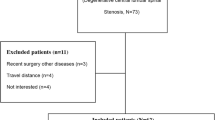Abstract
To assess whether a subjective questionnaire that measures the disability caused by balance disorders in daily life activities is correlated to objective assessment of balance in elderly patients with age-related instability. We included 37 subjects aged 65 years or more who presented balance disorders induced solely by age. Balance assessment was through the sensory organisation test and limits of stability of computerised dynamic posturography, the SwayStar system and the modified timed up and go test. The patients also completed the dizziness handicap inventory (DHI) questionnaire. The SwayStar balance control index (BCI) was most significantly correlated to the DHI score and the score of its different scales. When we divided the patients into subgroups according to DHI score, we only found statistically significant differences in the BCI and number of falls. In our population of elderly patients with instability, there is practically no correlation between the DHI and the static balance assessment. However, there is greater correlation with the BCI, which could show that dynamic balance is perceived as more disabling for these patients. In this case, when designing a rehabilitation protocol we should focus more on dynamic activities such as gait.



Similar content being viewed by others
References
López-Doriga P, Guillén F (1995) Epidemiología de los trastornos del equilibrio en ancianos. In: Perelló, Presbivértigo Barcelona, Prous JR pp 2–42
Boult C, Murphy J, Sloane P, Mor V, Drone C (1991) The relation of dizziness to functional decline. J Am Geriatr Soc 39:858–861
Hale HE, Perkins LL, May FE, Marks RG, Stewart RB (1986) Symptom prevalence in the elderly. An evaluation of age, sex, disease and medication use. J Am Geriatr Soc 34(5):333–341
Lin HW, Bhattacharyya N (2012) Balance disorders in the elderly: epidemiology and functional impact. Laryngoscope 122(8):1858–1861
Arellano B, Ramírez Camacho R (2003). Patología vestibular en el anciano. In: Ramírez Camacho R (ed) Trastornos del equilibrio. Un abordaje multidisciplinario. McGraw-Hill Interamericana, Madrid, pp 307–10
Neuhauser HK, von Brevern M, Radtke A, Lezius F, Feldmann M, Ziese T, Lempert T (2005) Epidemiology of vestibular vertigo. A neurotologic survey of the general population. Neurology 65(6):898–904
Padilla Ruiz F, Bueno Cavanillas A, Peinado Alonso C, Espigares Garcia M, Galvez Vargas R (1998) Frecuencia, características y consecuencias de las caídas en una cohorte de ancianos institucionalizados. Aten Primaria 21(7):437–445
Lord SR, McLean D, Strathers G (1992) Physiological factors associated with injurious falls in older people living in the community. Gerontology 38:338–346
Tinneti ME (2003) Clinical practice. Preventing falls in elderly persons. New Eng J Med 348:42–49
Murphy SL, Williams CS, Gill TM (2002) Characteristics associated with fear of falling and activity restriction in community-living older persons. J Am Geriatr Soc 50(3):516–520
Jacobson GP, Newman CW (1990) The development of the dizziness handicap inventory. Arch Otolaryngol Head Neck Surg 116(4):424–427
Pérez N, Garmendia I, Martín E, García Tapia R (2000). Adaptación cultural de dos cuestionarios de medida de la salud en pacientes con vértigo. Acta Otorrinolaringol Esp 51(7):572–80
Nashner LM. Computerize dynamic posturography (2011). In: Goebel JA (ed) Practical management of the dizzy patient. Lippincott Williams & Wilkins, Philadelphia, pp 143–70
Allum JH, Adkin AL (2003) Improvements in trunk sway observed for stance and gait tasks during recovery from an acute unilateral peripheral vestibular deficit. Audiol Neurootol 8:286–302
Podsiadlo D, Richardson S (1991) The timed “up and go” test. J Am Geriatr Soc 39:142–148
Rossi M, Soto A, Santos S, Sesar A, Labella T (2009) A prospective study of alteration of balance among patients with Parkinson’s disease: protocol of the postural evaluation. Eur Neurol 61(3):171–176
Whitney SL, Wrisley DM, Brown KE, Furman JM (2004) Is perception of handicap related to functional performance in persons with vestibular dysfunction. Otol Neurotol 25:139–143
Jacobson GP, Newman CW, Hunter L, Blazer GK (1991) Balance function test correlates of the dizziness handicap inventory. J Am Acad Audiol 2(4):253–260
Gill Body KM, Beniato M, Krebs DE (2000) Relationship among balance impairments, functional performance, and disability in people with peripheral vestibular hypofunction. Phys Ther 80:748–758
Cohen HS, Kimball KT (2003) Increased independence and decreased vertigo after vestibular rehabilitation. Otolaryngol Head Neck Surg 128:60–70
Pérez N, Martin E, Garcia-Tapia R (2003) Dizziness: relating the severity of vertigo to the degree of handicap by measuring vestibular impairment. Otolaryngol Head Neck Surg 128(3):372–381
Rossi-Izquierdo M, Santos-Pérez S, Soto-Varela A (2011) What is the most effective vestibular rehabilitation technique in patients with unilateral peripheral vestibular disorders? Eur Arch Otorhinolaryngol 268(11):1569–1574
Riva D, Mamo C, Fanì M, Saccavino P, Rocca F, Momenté M, Fratta M (2013) Single stance stability and proprioceptive control in older adults living at home: gender and age differences. J Aging Res 2013:561695
Girardi M, Konrad HR, Amim M, Hughes LF (2001) Prediciting fall risks in an elderly population: computer dynamic posturography versus electronystagmography test results. Laryngoscope 111(9):1528–1532
Varas-Fabra F, Castro Martín E, Pérula de Torres LA, Fernández Fernández MJ, Ruiz Moral R, Enciso Berge I (2006) Caídas en ancianos de la comunidad: prevalencia, consecuencias y factores asociados. Aten Primaria 38(8):450–455
Acknowledgments
This study was supported by a grant of the National Institute of Health Carlos III (National R&D&I Plan 2008–2011, dossier PI11/01328).
Conflict of interest
The authors report no conflicts of interest. The authors alone are responsible for the content and writing of the paper.
Author information
Authors and Affiliations
Corresponding author
Rights and permissions
About this article
Cite this article
Rossi-Izquierdo, M., Santos-Pérez, S., Del-Río-Valeiras, M. et al. Is there a relationship between objective and subjective assessment of balance in elderly patients with instability?. Eur Arch Otorhinolaryngol 272, 2201–2206 (2015). https://doi.org/10.1007/s00405-014-3122-3
Received:
Accepted:
Published:
Issue Date:
DOI: https://doi.org/10.1007/s00405-014-3122-3




